Building an Android app is a lengthy and challenging process that will cost you some money. Read on to find out what affects the final costs.
Android App Development Cost
Here is a mind-blowing fact. iOS is soon to sink into oblivion on the Asian market.
Although Apple gadgets are extremely popular in Asia, local users are not the same as in America. Therefore, it is impossible to talk about Asian customers as steady iOS customers. According to StatCounter, there has been a sudden decline in Apple gadgets in Asia. From more than 70% in 2012 to 20% last year.
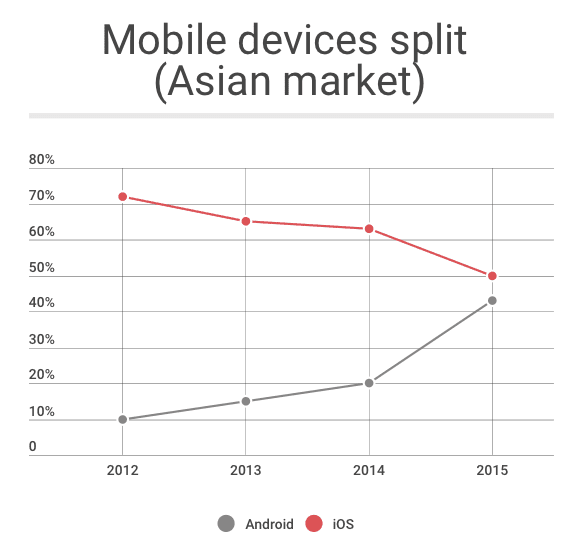
As the iPhone fatigue sets in combined with the desire to stand out, Apple is losing some of its lusters among Asia’s well-heeled consumers. On top of that, if we compare the iPhone price with any Android counterpart, the Apple device does not compare favorably in this case.
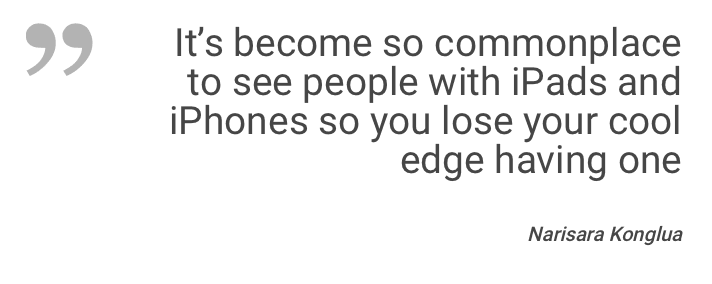
Anyway, that is not today’s agenda. We have just told you that choosing Android for mobile application development is a good place to go. And with Google Play Store making a comeback to China and reigning the market, Android app development is at its prime time.
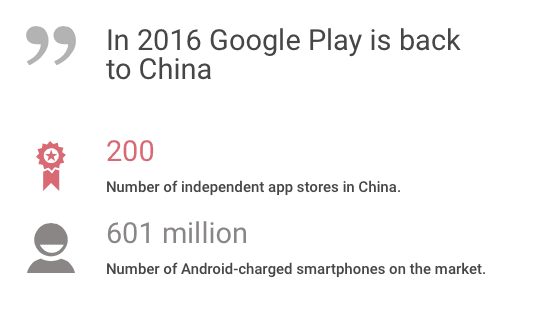
Here’s the deal. I have no idea how much building an Android app costs. This is the reason I’ve been doing some research and fishing for priceless bits of information to compile all pieces that affect the final cost. Let me introduce a checklist that outlines the major insights this article will provide:
- the present state of affairs with Android applications in the whole world;
- specialties of Android app development;
- up-to-the-moment features that are trending in a dev world right now;
- elements that affect the costs of Android app building;
- last but not least, factors that make up the overall price of your mobile app.
After reading this article you’ll surely become a pro in Android applications and will be able to evaluate the approximate costs for any Android application project. Without further ado, let’s get started!
Why Android apps are on a hype train
In general, there are a plethora of reasons why most people opt for Android apps instead of iOs ones. Just have a look at the numbers:
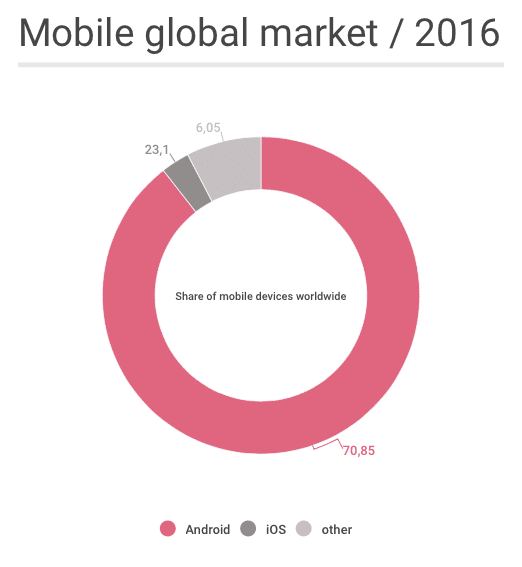
Here are the top reasons why it is more gainful to build Android apps:
- Java – a mighty coding language that is official for Android development. The reason why it’s the best for building Android apps is that apps can then be transported to other systems like Ubuntu or Blackberry. Therefore, most modest companies or startups that are short on money opt for Android apps.
- Accessibility – if you release an app on Google Play Store, users can check it out in mere hours after their launch. Things are not that quick with iOS apps, as they have to be previewed for half a month before approval. Additionally, updates can be added several times a day according to the feedback or complaints. On top of that, another handy feature of Android apps is limited access to the beta version. If the app has some defects, testers can improve it at the very beginning and release it refined to the general users.
- Advantageous entrance level – as most devs know the iOS market is for the chosen few, so to speak. You always need to try a bit harder to come aboard. Android, on the contrary, is much more welcoming and hassle-free. You can create an Android app on any platform you like from Mac to Windows. iOs apps, on the contrary, can only be built on Mac. The registration cost difference is also stunning: around $20 for Android as opposed to almost $100 for iOs.
- Cost-effectiveness – today, Android applications have become as cost-effective as iOS ones (sometimes even much more profitable), regardless of the existing partiality that iOS is utilized by more fancy, more open to paying, clients. Furthermore, the flourishing market of the overall industry is the purpose behind that – more than 1 billion gadgets with the Android motor available for the time of 2015.
Android in-app trends
The usage of mobile apps has grown exponentially. From millennials up through the older generations, everyone has a smartphone. Therefore, Android in-app trends have become a major attraction improving user experience and app performance.
The security of mobile applications
Cybersecurity has so far not been given due importance, which is why some of the “big guys” were affected by several incidents. Almost all technological giants think about new methods, providing security and data protection, taking into account the progress of attackers.
Virtual and augmented reality
While virtual reality completely replaces the environment, AR combines reality and digital technology. For a long time, AR and VR were two high-tech things represented only in computer games. Now the guys from Google began to use the potential of AR and VR in innovative areas, such as functions for Google Maps, which will offer the user directions in real-time using the phone camera. This technology offers the following benefits:
- better visual experience for customers.
- 3D presentation of products anywhere.
- fast sales through interactive interaction.
Shorter development cycles
Regardless of the common belief that Android apps call for quite a long time to deliver (read on for more details), lots of developers focus on shortening the development cycle. The shift from development to marketing stemmed from the fact that most developers want to maximize revenue. And thanks to the ‘UX first’ approach nowadays, cutting development time has become possible. And let’s be honest: we are loving simple and minimalistic interfaces anyway.
Businesses investing in mobile apps
Today, most companies have gone digital and are eager to leverage their online presence. Here’s when mobile apps come in with their blooming world of opportunities. As consumer behavior continues to evolve, companies have to adapt their approach to keep pace with their customers. Therefore, most companies are stepping closer to the mobile app market. The result is forthcoming. Numerous companies have stricken its reach in the twinkle of an eye thanks to enticing mobile apps.
Commonplace integration of payment services
Mobile wallets have become the preferred method of payment worldwide. People are more actively turning to mobile means of payment such as Apple Pay, Google Wallet with more flexible terms in payments. Also, Blockchain technology enters the payment arena, offering better security for mobile transactions.
On-demand applications
Uber, Airbnb, Booking.com, Instacart, Rinse, Postmates – the list of on-demand platforms goes on. By solving specific pressing problems, such applications shape our future. Uber uses location coordinates to offer on-demand cab services safely and cost-effectively, whereas Airbnb allows you to rent accommodation anywhere in the world.
Assimilation of wearable
Wearable devices have been closely integrated into our everyday life. From smartwatches and trackers to fitness bracelets and smart rings, our everyday life wouldn’t be complete without wearables. This year predicts the steady growth of those who want to get such gadgets. However, a lot of applications do not yet support the ability to work with wearable. Engineers are already implementing methods that provide seamless integration with minimal dependence on the smartphone.
How hard is it to build an edgy Android app?
Now that you are well aware of Android app benefits, let’s break down the Android development process. In the long run, your total application cost depends on the whole process.
And let’s get it straight. Android app development usually requires more time and costs than an iOS app. You might be wondering why. Let me unveil the mystery of Android mobile development, and primary points that result in longer implementation time compared to iOS one. And yes, there is no magic number. Instead, there are multiple factors at play.
More code
You didn’t expect that, did you? According to The App Solutions analysis, completing an Android app needs about 40% more code compared to iOS. We don’t mean that all code is manual, part of it is automated, however, devs need to check it, debug and maintain it in any case.
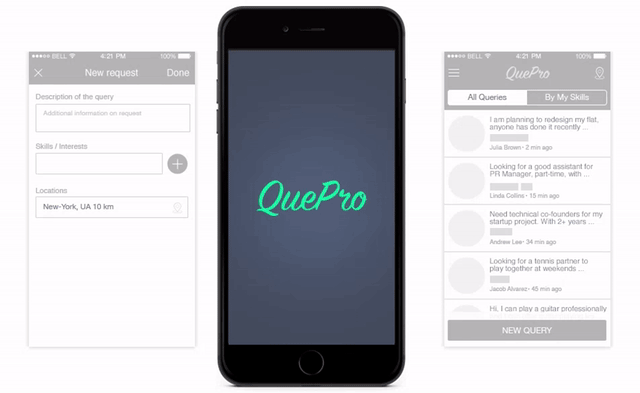
Time spent
Logically, if you need more code written, this leads to increased working time for devs. The numbers are almost identical – Android apps need around 30% more time as opposed to iOS.
Slower emulators
An important factor that affects the speed of Android app development is the operational speed of Android emulators. They completely mimic Android OS, emulating the ARM CPU & GPU, unlike the iOS Simulator, which runs x86 code on the hardware.
High fragmentation
If you look at the statistics you’ll see that there are a lot more users of the current iOS versions than Android. Project Treble was introduced back in 2017 and was supposed to help Android with its fragmentation issues. Its main purpose is to get updates to customers in a more timely fashion.
Fragmentation between the different devices is usually laid out as a pile of problems. Now every manufacturer has its own version of Android which has led to slower updates and different experiences depending on which version of Android you have. While iOS generally has no problem providing updates Android cannot say the same. As a matter of fact, two years of support is about the norm for Android devices where iOS devices generally maintain five years of support or more.
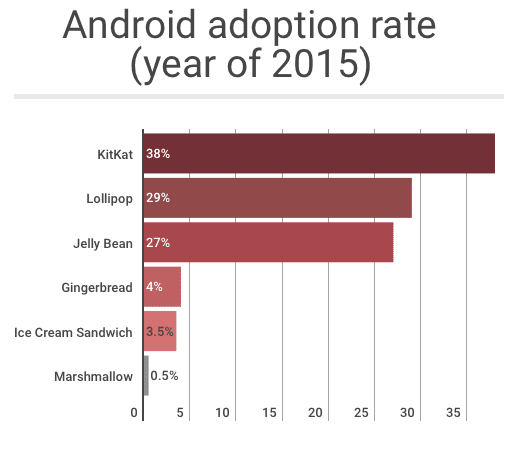
Android app development cost
Estimation model
Now that we’ve clarified what affects the cost of the app (quick reminder: number of hours), let’s sort out the pricing model. Usually, there are two kinds of pricing: the flexible one and the fixed pricing model. The former is also known as the Time and Material payment model. As it is flexible, you can alter and update this model as you go. The latter, on the contrary, is a fixed pricing model. Here you negotiate the end product from scratch and it is hard to make any changes there. This pricing model is geared towards long iteration, i.e. delivering the total project according to the deadlines. As a result, both pricing models differ in final costs. The fixed one is usually higher as it entails risk factors among other aspects.
Devoted team
Another key ingredient that affects the app cost is the team members. You might think that the dev team boils down to mobile app developers who lead your project. Wrong!
Here is an excessive list of pros who construct and perfect your app:
- Project Manager – a specialist whose main task is to manage the project as a whole including design and prioritization, task scheduling, control, communication, as well as rapid problem-solving. As part of this task PMs need to build a development plan, lead a team, set up the process of working on the project, provide feedback between the teams and the customer, eliminate interferences for teams, control the quality and delivery of the product on time;
- Senior developer or architect – this is the forward-running developer who possesses outstanding programming skills, mentors other devs and chooses the best tech solution for your project;
- Android coder(s) – is engaged in creating, updating, improving your app for smartphones, tablets, e-books, game consoles, and other devices running on the Android operating system;
- Designer(s) – UX design is responsible for the function, adaptability of the product, and what emotions it evokes in users. The clearer the interface, the easier it is for the user to get the result and perform the target action;
- QA Engineer(s) – is a quality assurance specialist whose activity is aimed at improving the software development process, preventing defects, and identifying errors in the product;
- Technical writer – this wizard is responsible for creating and updating technical documentation. He or she acts as a bridge between the user and the end product.
This pretty much sums up the basic structure of the perfect team. However, if your project is a complex one, the number can be bigger.
Type of application
Table-based application is the breeziest among all types. It allows you to show info, offer options, and forward extra materials.
Database apps are harder to build than the previous ones. They do a great job of displaying a great variety of data. These are linked to different sites or any other digital services and transmit needed data from these sources.
Dynamic applications are pretty much the same as the previous type. The only difference is that they withdraw information using API.
Gaming apps are the hardest to create. These apps include a large number of development stages from design and web development to testing and launching on service. As a result, the final cost is significantly higher compared to other types.
Now that we’ve briefed you on the app types, let’s have a look at the best app developers to assign your brilliant project idea. Luckily today, you have lots of options starting from the part of the world to the hourly rate.
- USA/Canada-based development teams – $60 to $260/hour;
- Westen Europe – $40 to$180/hour;
- Eastern Europe – $30 to $160/hour;
- Australia – $60 to $160/hour;
- India – $15 to $90/hour.
After you’ve decided on the development team, you can get onto discussing the app functionality and estimating the build hours needed to develop your brainchild. Then, you just sum up all hours of your team and multiply these on the hourly rate – basic math.
The Bottom Line
As you see, the cheapest option for app development in India. However, make sure to study the portfolio of a particular crew and check the overall reputation. In any case, rumor has it that Indian development can turn out a bit differently than you expect. But the rumor is a rumor, so make sure to check it yourself. Eastern Europe devs are known for being highly professional and charging a decent price. American and Australian dev teams are the most expensive app squads. However, if you hire such a team, you can sit back and relax being confident in the final result.
And voila! Now you have some thought-provoking information on developing your brain-child. A welcome addition – you can finance a project in parts, so it is not obligatory to have the whole budget from the very beginning. On top of that, you can follow our link and calculate the cost of Android app development.